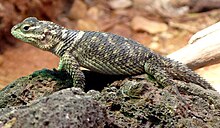| Crevice spiny lizard | |
|---|---|

| |
|
Scientific classification
| |
| Domain: | Eukaryota |
| Kingdom: | Animalia |
| Phylum: | Chordata |
| Class: | Reptilia |
| Order: | Squamata |
| Suborder: | Iguania |
| Family: | Phrynosomatidae |
| Genus: | Sceloporus |
| Species: | S. poinsettii
|
| Binomial name | |
| Sceloporus poinsettii | |
Sceloporus poinsettii, the crevice spiny lizard, is a species of small, phrynosomatid lizard.
Etymology
The epithet, poinsettii, is in honor of American physician, botanist, and statesman, Joel Roberts Poinsett. [2] [3]
Geographic range
In the United States, Sceloporus poinsettii occurs in the Chihuahua Desert and Edwards Plateau regions of Texas and New Mexico. [4] [5] [6] In Mexico it occurs in the border states from the Sierra Madre Occidental of Sonora, eastward through Chihuahua, Coahuila, and Nuevo Leon. [7] [8] [9] Southward its distribution is less well established, although it is known to occur throughout of the state of Durango, parts of Zacatecas, with additional records from San Luis Potosi in the southeast, and the Pacific slopes of the Sierra Madre Occidental of northern Jalisco in the southwest. [10] [11]
Description
The crevice spiny lizard is typically grey in color, but sometimes can have a ruddy red- brown appearance with a black and white collar around the neck region. The underside is typically light grey, but males often have blue patches on either side of their bellies. The tail typically has black banding. Their scales have a distinctly spiny texture. They can grow to 11.8 cm (4.6 in) snout-to-vent length, and 31.1 cm (12.2 inches) total length. [12]
Behavior

Crevice spiny lizards are typically shy and nervous, fleeing up a rock face or into a crevice if approached. They prefer semi-arid habitats, often of limestone rock, where there are numerous holes and easily accessible cracks.
Diet
Crevice spiny lizards are insectivorous, consuming a wide variety of spiders, beetles, and other insects, but they will sometimes also consume tender vegetation.
Reproduction
Sceloporus poinsettii is one of the several species of Sceloporus that are ovoviviparous. Breeding occurs in the spring, and a litter of up to 11 young are born in midsummer.
Subspecies
Five subspecies are recognized as being valid, including the nominotypical subspecies [13]
- Sceloporus poinsettii amydrus Webb, 2006
- Sceloporus poinsettii axtelli Webb, 2006
- Sceloporus poinsettii macrolepis H.M. Smith & Chrapliwy, 1958
- Sceloporus poinsettii poinsettii Baird & Girard, 1852
- Sceloporus poinsettii polylepis H.M. Smith & Chrapliwy, 1958
References
- ^ Hammerson, G.A.; Frost, D.R.; Santos-Barrera, G. (2007). "Sceloporus poinsettii". IUCN Red List of Threatened Species. 2007: e.T64138A12748434. doi: 10.2305/IUCN.UK.2007.RLTS.T64138A12748434.en. Retrieved 2 July 2023.
- ^ Beltz, Ellin (2006). Scientific and Common Names of the Reptiles and Amphibians of North America - Explained. http://ebeltz.net/herps/biogappx.html
- ^ Beolens, Bo; Watkins, Michael; Grayson, Michael (2011). The Eponym Dictionary of Reptiles. Baltimore: Johns Hopkins University Press. xiii + 296 pp. ISBN 978-1-4214-0135-5. (Sceloporus poinsetii, p. 209).
- ^ Degenhardt, W. G., C. W. Painter, and A. H. Price. 1996. Amphibians and Reptiles of New Mexico. University of New Mexico Press, Albuquerque, New Mexico. xix, 431 pp. ISBN 978-0826338112
- ^ Dixon, J. R. 2013. Amphibians and Reptiles of Texas, with Keys, Taxonomic Synopses, Bibliography, and Distribution Maps. 3nd Edition. Texas A&M University Press. College Station, Texas. viii, 477 pp. ISBN 978-1603447348
- ^ Köhler, G. and P. Heimes. 2002. Stachelleguane: Lebensweise, Pflege, Zucht. Herpeton, Verlag Elke Köhler, Offenbach, Germany. 174 pp. ISBN 3-9806214-9-9
- ^ Lemos Espinal, J. A. (Editor) 2015. Amphibians and Reptiles of the US-Mexican Border States. Texas A&M University Press. College Station, Texas. x, 614 pp. ISBN 978-1-62349-306-6
- ^ Lemos Espinal, J. A., G. R. Smith, J. R. Dixon, and A. Cruz. 2015. Amphibians and Reptiles of Sonora, Chihuahua, and Coahuila, Mexico. CONABIO, Mexico D. F. 668 pp. ISBN 978-607-8328-27-7
- ^ Lemos Espinal, J. A., G. R. Smith, and A. Cruz. 2018. Amphibians and Reptiles of Nuevo León. Eco Herpetological Publishing and Distribution. Rodeo, New Mexico. x, 370 pp. ISBN 978-1-938850-25-7
- ^ Lemos Espinal, J. A. and J. R. Dixon. 2013. Amphibians and Reptiles of San Luis Potosí. Eagle Mountain Publishing, LC. Eagle Mountain, Utah. i-xii, 1-300 pp. ISBN 978-0-9720154-7-9
- ^ Lemos Espinal, J. A., G. R. Smith, and R. Valdez Laresz. 2019. Amphibians and Reptiles of Durango, Mexico. Eco Herpetological Publishing and Distribution. Rodeo, New Mexico. xii, 416 pp. ISBN 978-1-938850-27-1
- ^ Smith, H.M., and E.D. Brodie, Jr. (1982). Reptiles of North America: A Guide to Field Identification. New York: Golden Press. 240 pp. ISBN 0-307-13666-3. (Sceloporus poinsetti, pp. 118-119).
- ^ "Sceloporus poinsettii ". The Reptile Database. www.reptile-database.org.
Further reading
- Baird, Spencer F., and Charles Girard (1852). "Characteristics of some New Reptiles in the Museum of the Smithsonian Institution". Proc. Acad. Nat. Sci. Philadelphia 6: 125-129. (Sceloporus poinsettii, new species, pp. 126–127).
- Behler, John L., and F. Wayne King (1979). The Audubon Society Field Guide to North American Reptiles and Amphibians. New York: Alfred A. Knopf. 743 pp. ISBN 0-394-50824-6. (Sceloporus poinsettii, pp. 527–528 + Plate 354).
- Conant, Roger (1975). A Field Guide to Reptiles and Amphibians of Eastern and Central North America, Second Edition. Boston: Houghton Mifflin. xviii + 429 pp. + Plates 1-48. ISBN 0-395-19979-4 (hardcover), ISBN 0-395-19977-8 (paperback). (Sceloporus poinsettii, pp. 100–101 + Plate 17 + Map 66).
- Stebbins, Robert C. (2003). A Field Guide to Western Reptiles and Amphibians, Third Edition. Boston and New York: Houghton Mifflin. xiii + 533 pp. ISBN 978-0-395-98272-3. (Sceloporus poinsettii, p. 285 + Plate 31 + Map 88).
- Zim, Herbert S., and Hobart M. Smith (1956). Reptiles and Amphibians: A Guide to Familiar American Species: A Golden Nature Guide. New York: Simon and Schuster. 160 pp. (Sceloporus poinsetti, pp. 56, 155).
